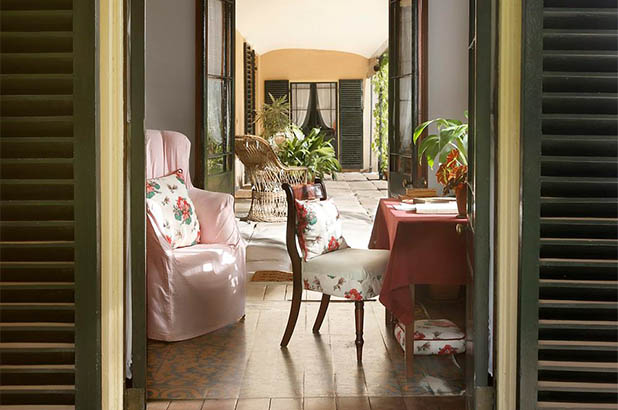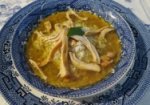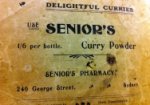Visitors to Elizabeth Farm this Sunday 7 April will have the opportunity to make curry powder from a Jane Austen family recipe as part of a Regency-inspired Vintage Sunday, the first of a new series of programs that take you back in time, to enjoy the simplicity of a by-gone era.
What Jane ate…
“…much was said and much was ate” Jane Austen, Mansfield Park
Thanks to the extraordinary legacy of her written works, we know what Jane Austen said. But working out what she ate is another matter. Fortunately there has been much scholarly research on Jane Austen and food, based on her own personal records and the food and meal occasions that form the backdrop for much of her story telling.
While Jane and her characters tease us with mere glimpses of what was on their tables, there is a more concrete resource from the Austen family collection. Martha Lloyd, a family friend who lived with the Austen’s, and eventually married Jane’s brother, Francis, compiled a Household Book which survives today. It contains over one hundred recipes. Like many domestic cookery manuscripts, Martha Lloyd’s collection was compiled over time, with contributions from friends and associates.
Typical of the period, curries were starting to feature on finer tables, and Martha’s book includes a ‘Curree’ powder, a Curry Soup, and A Receipt to Curry after the Indian Manner. It is highly likely that Jane and the family experimented with exotic flavours and aromas from the East. They’re less complex than modern Indian curries, but ‘authentic’ to the Regency period.
Mrs Jane Fowle’s Curree Powder
Ingredients
- 2 teaspoons ground galangal
- 1 teaspoon yellow turmeric
- 1/4 teaspoon mild chilli powder
- cayenne pepper (optional)
- 5 teaspoons rice flour
Note
This recipe is part of Martha Lloyd's recipe collection, published in The Jane Austen cookbook (Maggie Black & Deirdre Le Faye, British Museum Press, 1995, p103). Martha was a close friend of Jane Austen's. After a long association with the family she married Jane's brother Francis, and it is understood that the recipes in Martha compiled would have been used by the Austen family.
Martha attributes this recipe to another family friend, Mrs Jane Fowle. It is a particularly interesting curry powder in that it calls for galangal, a South-East Asian spice related to the much more commonly available ginger. Turmeric and galangal were not regular household ingredients in Regency times, and would have been bought from a specialist grocer or apothecary.
This curry blend, here in its original spelling, is not nearly as complex in flavour as the curry powders we know today, and the galangal makes it seem quite sweet. To me, it is reminiscent of a Japanese-style curry, but would also serve as the spice base for a mulligatawny or kedgeree with all the trimmings:
Take of Termeric [i.e. turmeric] Root, & Galangal Root each half an oz. Best Cayenne Pepper a quarter of an oz. Let the Termeric & Galangal be reduced to a fine powder separately, then mix them with the other articles & keep for use – NB. two oz of Rice powderd to be mixed also with the other ingredients. – Mrs Jane Fowle.
The original recipe makes about 3/4 cup, so if you're working from that you may want to make a smaller batch as a trial. The modern version below is enough for a curry that uses about 500g chicken or meat, or you can multiply the ingredients for a larger batch.
Directions
| Mix all the ingredients together and store in an airtight container. | |
A Receipt to Curry after the Indian Manner
Ingredients
- 500g chicken thighs
- 2 tablespoons butter
- 2 cloves garlic, chopped
- 1 onion, sliced
- 2 tablespoons curry powder (Jane Fowles 'curree' powder or generic Madras style)
- 3 cups chicken stock
- cayenne pepper, to taste
- 3 tablespoons lemon juice
- basmati rice, to serve
- fruit chutney or pickle, to serve
Note
This recipe is part of Martha Lloyd's recipe collection, published in The Jane Austen cookbook (Maggie Black & Deirdre Le Faye, British Museum Press, 1995, p56). Martha was a close friend of Jane Austen's, and after a long association with the family she married Jane's brother Francis. Her cookbook also included a recipe for 'curree' powder, given to her from another family friend, Mrs Jane Fowle. It is ideal for this recipe, otherwise use a mild Madras style store-bought blend.
Cut two Chickens as for fricasseeing, wash them clean & put them in a stew pan with as much water as will cover them, with a large spoonful of salt sprinkle them & let them boil till tender covered close all the time, skim them well; when boiled enough take up the Chickens & put the liquor of them in a pan, then put half a pound of fresh butter in the pan & brown it a little, put into it two cloves of garlic, a large onion sliced & let these all fry brown often shaking the pan, then put in Chickens & sprinkle over them two or three spoonfuls of curry powder, then cover them close & let the Chickens do till brown frequently shaking the Pan, then put in the Liquor the Chickens were boiled in & let all stew till tender. If acid is agreeable squeeze the juice of a Lemon or Orange into it.
Directions
| Cut the chicken thighs into bite-sized pieces, trimming away any visible fat. | |
| Melt the butter in a frying pan and sauté the chicken pieces over low heat until they start to brown. Remove chicken from pan and set aside. | |
| Sauté the garlic and onion until softened. Sprinkle the curry powder over the onions and sauté gently, stirring until the powder is evenly distributed through the onions. | |
| Add 1 cup of chicken stock, stirring to incorporate any brownings from the bottom of the frying pan. Return the chicken and any juices to the pan. Add the remaining stock, taste for salt and spiciness – the amount of salt will depend on the stock you have used; add cayenne if using. Simmer for 15 minutes, stirring occasionally as the sauce thickens. Add a little water if the curry becomes too dry. Add lemon juice and the curry is ready to serve. | |
| Serve with basmati rice and fruit chutney on the side. | |
Sources
We find two Jane Austen ‘food biographies’ really useful:
- The Jane Austen Cookbook by food historian Maggie Black and ‘Austenian’ scholar Deirdre Le Faye (British Museum Press, 1995)
- Jane Austen and Food by Maggie Lane (The Hambledon Press, 1995), which delves deeply into the literature itself.

 Print recipe
Print recipe

